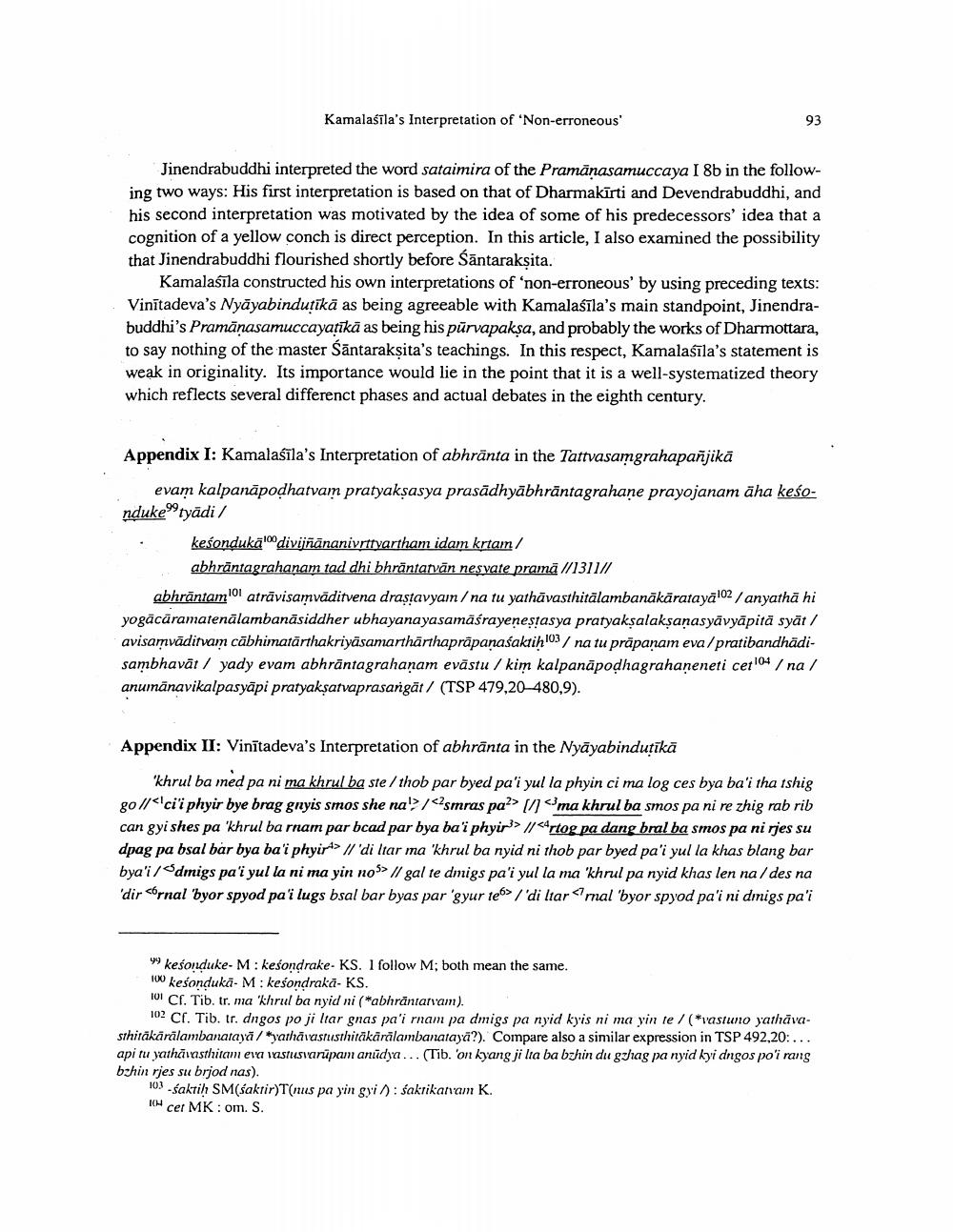________________
Kamalaśīla's Interpretation of 'Non-erroneous'
Jinendrabuddhi interpreted the word sataimira of the Pramānasamuccaya I 8b in the following two ways: His first interpretation is based on that of Dharmakīrti and Devendrabuddhi, and his second interpretation was motivated by the idea of some of his predecessors' idea that a cognition of a yellow conch is direct perception. In this article, I also examined the possibility that Jinendrabuddhi flourished shortly before sāntarakṣita.
Kamalaśīla constructed his own interpretations of ‘non-erroneous' by using preceding texts: Vinītadeva's Nyāyabindutīkā as being agreeable with Kamalaśīla's main standpoint, Jinendrabuddhi's Pramānasamuccayatīkā as being his pūrvapaksa, and probably the works of Dharmottara, to say nothing of the master Sāntarakṣita's teachings. In this respect, Kamalasīla's statement is weak in originality. Its importance would lie in the point that it is a well-systematized theory which reflects several differenct phases and actual debates in the eighth century.
Appendix I: Kamalaśīla's Interpretation of abhrānta in the Tattvasamgrahapanjikā
evam kalpanāpodhatvam pratyaksasya prasādhyābhrāntagrahane prayojanam äha kesonduketyādi / . kesondukā'divijñānanivrttyartham idam krtam/
abhräntagrahanam tad dhi bhräntatvān nesvate pramā //1311// abhräntam' atrāvisamvāditvena drastavyam/na tu yathāvasthitālambanākärataya102 / anyatha hi yogäcäramatenālambanāsiddher ubhayanayasamāśrayeneștasya pratyaksalakṣaṇasyävyāpitä syāt / avisamvāditvam cābhimatarthakriyāsamarthārthaprāpanasaktih 103 / na tu präpanam eva/pratibandhädisambhavāt / yady evam abhrāntagrahanam evāstu /kim kalpanāpodhagrahaneneti cet104 / na / anumänavikalpasyäpi pratyakșatvaprasangät/ (TSP 479,20-480,9).
Appendix II: Vinītadeva's Interpretation of abhrānta in the Nyāyabindutīkā
'khrul ba med pa ni ma khrul ba ste / thob par byed pa'i yul la phyin ci ma log ces bya ba'i tha Ishig go //<lci' phyir bye brag gnyis smos she na! /<smras pa ma khrul ba smos pa ni re zhig rab rib can gyi shes pa 'khrul ba rnam par bcad par bya ba'i phyiny> //<rtog pa dang bral ba smos pa ni rjes su dpag pa bsal bar bya ba'i phyir'> // 'di ltar ma 'khrul ba nyid ni thob par byed pa'i yul la khas blang bar bya'i /dmigs pa'i yul la ni ma yin nos ll gal te dmigs pa'i yul la ma 'khrul pa nyid khas len na/des na 'dir <brnal 'byor spyod pa'i lugs bsal bar byas par 'gyur te> /'di ltar mal 'byor spyod pa'i ni diigs pa'i
o kesonduke- M: kesondrake. KS. I follow M;both mean the same. 100 kesondukā- M: kesondraka-KS. 101 Cf. Tib. tr. ma 'khrul ba nyid ni (*abhräntarvam).
102 C. Tib. tr. dngos po ji ltar gnas pa'i rnam pa dmigs pa nyid kyis ni ma yin te /(*vastuno yathāvasthitäkärālambanataya / *yathāvastusthitākārālambanatayā?). Compare also a similar expression in TSP 492,20:... api tu yathāvasthitam eva vastusvarüpam anūdya... (Tib. fon kyang ji lia ba bzhin du gohag pa nyid kyi dngos po'i rang bzhin rjes su brjod nas).
103 -saktih SM(saktir)T(nus pa yin gyi/): sakrikanam K. 104 cer MK : om. S.




